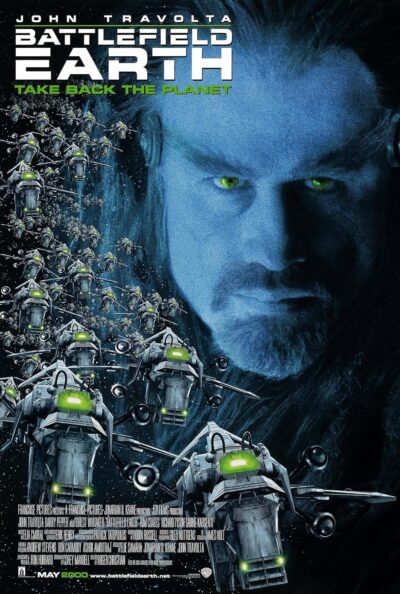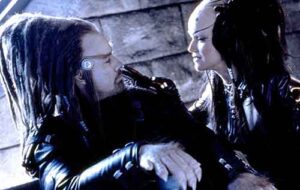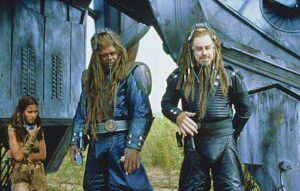A rare example of a film to which the passage of time has actually been kind. BATTLEFIELD EARTH, an independently made adaptation of a popular novel by pulp legend and Scientology founder L. Ron Hubbard, was a longtime passion project for its co-producer/star John Travolta (a.k.a. “Mr. Scientology”) and a massive failure upon its release in 2000. Its connection with scientology certainly didn’t help its chances, and nor did the beyond-cringey “Go Psychlo!” slogan tacked on by its distributor Warner Bros. For a time BATTLEFIELD EARTH joined the ranks of PAINT YOUR WAGON, HEAVEN’S GATE and ISHTAR in being synonymous with “flop,” but twenty-plus years later, viewing the film after all the furor and ridicule have died down, it emerges as, surprisingly, not all bad.
Certainly it has its issues, starting with the source material. Hubbard’s novel may have been published in 1982, but its complete lack of prominent female characters and unsubtle black-and-white morality (with its impossibly pure-hearted hero, nicknamed Goodboy, and bad guys who are really bad) demonstrated that Hubbard never quite put his 1930s pulp fiction origins behind him. Another problem is that the script only covered the 900-plus page book’s first half, with the second portion intended to be dramatized in a never-made sequel.
What the film had in its favor was Roger Christian as director. He was personally recommended to Travolta by George Lucas, for whom Christian worked as a set decorator (on STAR WARS) and second unit director (on RETURN OF THE JEDI and THE PHANTOM MENACE). Christian’s directorial career has been hit-and-miss, containing one great film (BLACK ANGEL) and some outright clunkers (STARSHIP, MASTERMINDS), with BATTLEFIELD EARTH ranking somewhere in the middle.
This “Saga of Year 3000” takes place in a United States (Montreal, actually) decimated by aliens from the planet Psychlo. The surviving humans serve as slave labor for the cone-headed Psychlos, who cackle incessantly, sport dreadlocks and wear breathing tubes, with their primary aim being to mine the planet’s resources. Terl (Travolta) is a Psychlo security chief confined to Earth due to his intransigent nature; he’s scheming to get his hands on a gold deposit with which he plans to bribe his superiors into allowing him to leave the planet.
Jonnie “Goodboy” Tyler (Barry Pepper) is a recently acquired human slave whose boldness and ingenuity impress Terl. After twice escaping and being recaptured Jonnie is taken under Terl’s wing, who blasts Psychlo language into Jonnie’s head via an electronic device, trains him as a pilot and kidnaps his girlfriend Chrissy (Sabine Karsenti), to whose neck is attached and explosive collar Terl threatens to detonate if Jonnie doesn’t agree to lead the gold mining operation. Jonnie goes through with the job but uses his newfound flying skills to surreptitiously collect a cache of weaponry and gold from Fort Knox, which is used in place of the wealth that’s supposedly being mined. Jonnie also organizes a band of revolutionary-minded humans, leading to an all-out human-Psychlo clash.
A quick rundown of this film’s two major issues: 1). It has a rushed feel, the result of a prohibitively low budget and editing that (in common with many early aughts blockbusters) is too kinetic and undisciplined for its own good, and 2). John Travolta was given a severe overabundance of screen time as the evil yet supposedly charismatic antagonist Terl. This is a problem because, simply, neither the character or Travolta’s interpretation are very interesting (Forest Whitaker fares much better as his morally ambiguous sidekick, as does Barry Pepper in the underwritten hero role, which was initially slated for Travolta).
Yet Christian, cinematographer Giles Nuttgens (ASYLUM) and their collaborators worked hard to create unique and distinctive visuals. They may overdo the dutch tilts (whose primary purpose, it’s been claimed, was to allow normal-sized actors to share the screen with the eight foot Psychlos), with literally every shot but the final one dutched, and also the color filters that denote shifts in mood and scenery. Those things, however, are integral in imparting a futuristic atmosphere. Christian is also to be commended for not overloading his film with CGI, utilizing mostly practical settings and effects until the mayhem packed final twenty minutes (when the CGI is inevitably allowed to take over).
Bold visual design doesn’t automatically make for a quality film, but in this case does make for an interesting one that holds up far better than contemporaneous sci fi epics like LOST IN SPACE, DEEP IMPACT, the Tim Burton PLANET OF THE APES, MEGIDDO and even, I’d argue, the STAR WARS prequels. BATTLEFIELD EARTH, the “worst movie ever made” (as many like to claim)? Not quite.
Vital Statistics
BATTLEFIELD EARTH
Morgan Creek Productions/Franchise Pictures/Warner Bros.
Director: Roger Christian
Producers: Jonathan Krane, Elie Samaha, John Travolta
Screenplay: Corey Mandell, J.D. Shapiro
(Based on a novel by L. Ron Hubbard)
Cinematography: Giles Nuttgens
Editing: Robin Russelle
Cast: John Travolta, Barry Pepper, Forest Whitaker, Kim Coates, Richard Tyson, Sabine Karsenti, Michael Byrne, Christina Tessier, Sylvain Landry, Richard Tyson, Christopher Freeman, John Topor, Shaun Austin-Olsen, Tim Post, Earl Pastko, Michael Perron, Michael MacRae, Todd McDougall, Derrick Damon Reeve, Kelly Preston, Marie-Josee Croze



